FAA proposed regulation has powerfully captured the attention of many pilots. Pilots have tons of questions. We have some answers. Everyone has a lot to read.
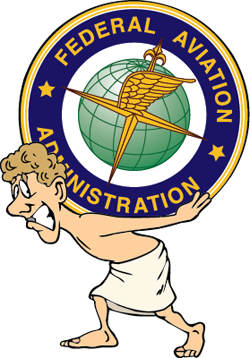 But… uggghhh! Who wants to read this stuff? If it doesn’t put you to sleep, it might infuriate you.
But… uggghhh! Who wants to read this stuff? If it doesn’t put you to sleep, it might infuriate you.
Overall, FAA’s proposal has been warmly received as it opens the door to more capable aircraft that a Sport Pilot can fly. That’s good but the document has problems, too. Following are four examples…
This article is a longer, more challenging read than one about an aircraft.
If you prefer to listen or watch, I recommend the podcast and a video below.
Mosaic’s language invigorated many readers when the NPRM expressed support for a Sport Pilot (certificate holder) to fly at night — with proper training and a logbook endorsement. Yet then the proposal refers to other FAA regulations that require BasicMed or an AvMed. If you must have a medical, you are not exercising the central privilege of Sport Pilot. Why suggest that a Sport Pilot can do things that are blocked by other regulation? This conflict should be resolved.
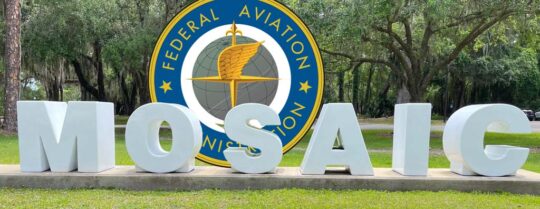
With several vertical graphics, this article may view best on a smartphone or tablet. When using a browser on laptop or desktop, adjust your window size for easier reading.
Another opportunity gap involves aerial work. We’re pleased LAMA’s request was included but it requires a Commercial certificate to fly for compensation and this requirement eliminates powered parachutes and weight shift trikes, for which no Commercial certificate is available. This is discriminatory and should be fixed.
Maintenance experts have lots of questions; see the video at bottom.
ASTM standards writers raised questions about the value of noise regulations included for no present gain, “requiring solutions before the problem exists.” This appears to have political motivations.
You may find other aspects of Mosaic that urge you to comment. If so, you will find the following helpful…
Mosaic Study Guide
I can’t imagine anyone genuinely enjoys reading Mosaic. The Notice of Proposed Rule Making (NPRM) encompasses many pages in dense language; it’s tedious to review.
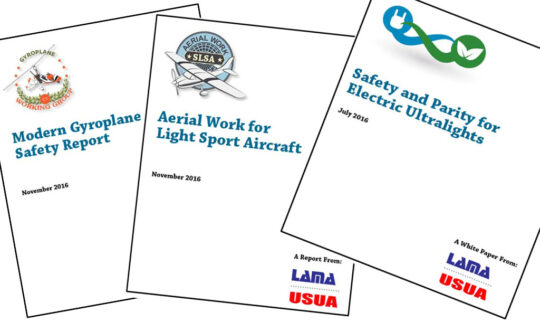
Beginning in 2014 — well before Mosaic existed — Roy and I spent years advocating FAA on behalf of the LSA industry and the pilots that fly those light aircraft. Roy was the lead author on several white papers LAMA submitted to support each of its requests. They went over so well with FAA that they are mentioned in the footnotes.
As you will see in the attached PDF Study Guide, Roy has done a monster amount of work in reformatting the documents so that you can walk through it and find what you want much easier.
GET THE STUDY GUIDE HERE (then download to use a reader with Bookmarks)
The magic of Bookmarks help you jump around the lengthy document. This view is from an Apple iPad using Adobe Acrobat Reader (free download) to view the document and move around within it.
Roy also addressed specific comments I had, whereupon reading one section, FAA refers to another, and then to another. Before long, you forgot where you started and struggle to retrace your steps. You also need Internet access to study FARs published outside the NPRM. The continuous back-and-forth makes studying the document significantly harder and slower yet the clock is ticking on public comments. At this writing we have just over 60 days left.
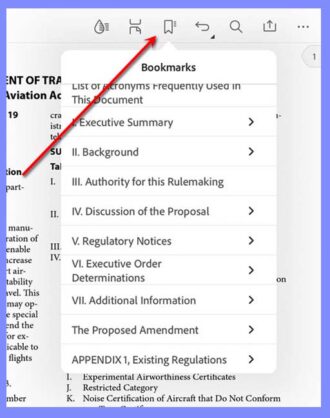
Bookmark icons may differ by platform and software but make navigating the document easier. Here are the sections Roy isolated so you can focus on areas of interest. TRIANGLES appear when more information is available.
Reviewing the NPRM is far easier with this PDF Study Guide because of the bookmarks, links, and back-links, plus already-yellow-highlighted text which (which shows what current FARs will be changed plus some lightly-colored text that illustrates where FAA will insert new language. These all represent major time-savers.
Mosaic will still take a significant effort to review carefully, but Roy made the task much easier and faster.
Magic of Bookmarks
If you open the Study Guide with Adobe Acrobat on almost any device or computer (the Reader version is free) — or if you use Preview on Apple laptops/desktops — you will gain access to the bookmarks (look for a small icon in the upper right of a tablet or a smart phone; in Preview, show the Table of Contents. On both, use the triangles to drop down further and further). Bookmarks are your navigation friend, helping you jump to places of interest or study.
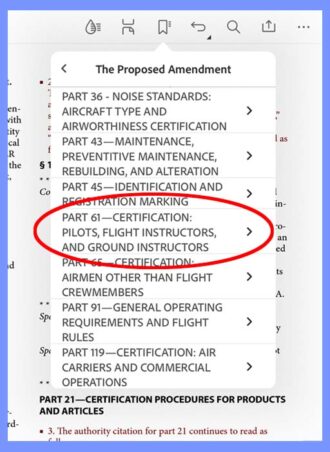
To find more about night flying by Sport Pilots, you can click or tap the triangle on this FAR (Part 61).
Roy even embedded “go-back” buttons on some pages when reviewing the FARs. This helps readers not get lost in their investigations.
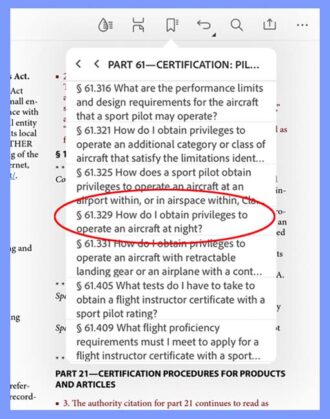
Within the FARs menu, you may have to scroll down for more topics. This example is for night operations.
Of course, within Acrobat (or Preview), you can Search for any text.
I observe for you that such ease of review was not possible when the SP/LSA regulation was released in 2004 (three years before the iPhone was introduced and before Facebook or Twitter). The World Wide Web was only nine years old at the time.
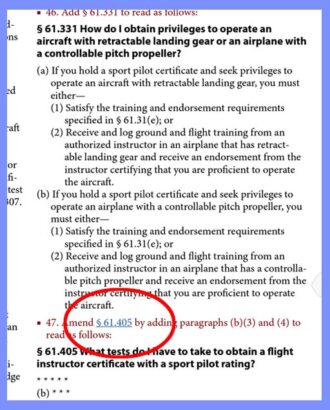
Links within the Study Guide let you look up the many FAR references made in the NPRM. No Internet is needed for this link. ••• The magenta-colored text shows where FAA will insert new text.
When reviewing Mosaic I recommend you follow aspects of particular interest to you rather than try to absorb the whole thing.
However deep you go, Roy made it incredibly easier. Thanks, Roy!
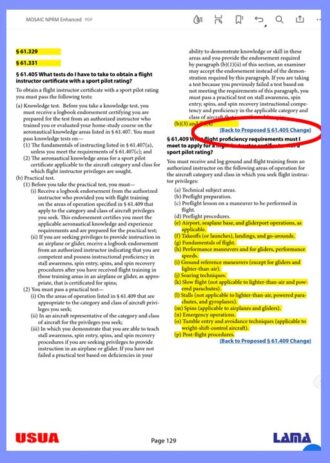
To help you not get lost in the FARs, Roy embedded “Back” buttons in strategic locations (circle). ••• YELLOW highlighted text denotes current-day FARs that will be changed by Mosaic.
When you are ready to comment to FAA, use this link. We’ll have more advice on commenting as soon as possible but here’s some basic tips:
- Keep your remarks to a purpose; ask for something.
- Make specific requests.
- Reference language when changes are needed.
- Be constructive; no ranting.
- Be original; use your own words.
To see Mosaic comments already made, use this link.
More-More-More
M O S A I C
More about Mosaic? — John Zimmerman, president of Sporty’s, thought our conversation in this edition of the “Pilot’s Discretion” podcast conveyed a lot of good information (audio—42 minutes). John was an excellent interviewer. Click the image below to go directly to the podcast.
Many readers are keen to learn more about the maintenance aspects of Mosaic. Experts Carol and Brian Carpenter give you their view in this video. The team notes several points deserving more attention. (Length: 59 minutes)


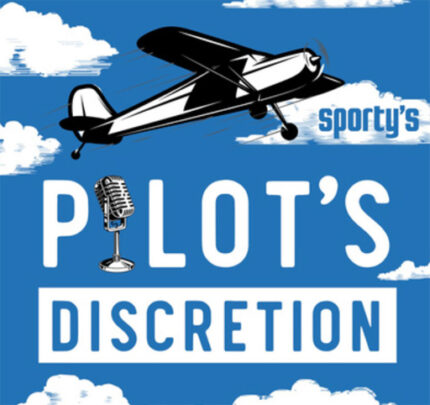

Have they extended the comment period?
Yes, a petition by several maintenance organizations for an extension was accepted by FAA. I believe the new date is January 22, 2024. Of course, this will extend the time FAA needs to review all comments and make changes such that I now would not expect the final regulation before April 2025.
Lots of stuff to read, so here is some more.
If you hold a LSA Repairman certification and additional aircraft are added to the LSA flying list, then will my Repairman certification allow me to service and sign off on those aircraft as well?
What do you think?
Excellent job, Dan and Roy!
Here in Brazil the LSA Manufacturers are starting a discussion with ANAC (our FAA), to understand which provisions could be incorporated to our current regulations.
This contribution of yours will be of a great deal of help!
On the maintenance side of the businees, as the VP for the Brazilian Association for Aeronautical Maintenance – MANTAER, I am very concerned on how the system can provide good quality maintenance and continuous airworthiness warranty for a growing fleet of newly designed and high technology light aircraft.
As a matter of fact, this discussion is already in course, between LSA Manufacturers and ANAC as we speak.
Thanks a lot for your continuous support for the Light Sport Aviation!
Thanks Dan, a wonderful resource
Dan;
Great information. I’m still reviewing the document and the information you passed along is a great help as I was getting lost without the links.
The aircraft and pilot privileges are a great step forward for GA, but the maintenance section is a nightmare. Having an ELSA and the LSI (light sport Inspection) ticket has been the way to go prior to this unless one needs the SLSA for business operations in which case the LSR (light sport repair) ticket fit the bill. The problem is that the way this rule is written, even an A&P IA may need additional training to inspect these new aircraft. I would hate to see people buy new aircraft and then not be able to find maintenance because the maintenance training is not available. I was happy to see that Carol and Brian are pointing this out as I hadn’t even thought about the electric propulsion training that will be needed. Clearly the FAA needs to take this back into the committee after the comment period and fill in the details before releasing it for a second comment period.
I’m maintenance centric in my thinking as I’m frustrated that the FAA pushed ADSB-out down GA’s throat without thinking about the maintenance side. My ELSA is coming up on it’s 2-year transponder check and the closest location I’ve found to do the check is an hour away.Then there is the issue of getting an appointment. I wish I could just pull the circuit breaker and fly without ADSB!
v/r
Tim
Dan, I want to express my THANKS to you, Roy, Carol & Brian for taking the leadership role and producing this outstanding information and action platform. The efforts are excellent and making a huge positive impact on our ability to effectively provide input to the regulatory body.
Thanks, Jack. That’s very kind of you to say, and I’ll pass along your warm words. Please, encourage everyone to comment. The more the better!
Will do. Posted on the Flying Legend user site this morning.
Thank you for calling out the medical requirement for night flight in clear language. I’ve seen so many articles dance around it being careful politically with the FAA by saying something along the lines of a SPL can do xyz with a DL. Then say a SPL can also fly at night and maybe others things with endorsement. Completely skipping it isn’t just a endorsement for night flights.
I wrote about night and medical as that is clearly what Part 61 regs say BUT I am hopeful that they correct the internal conflicts of the document and remove the medical requirement. I ask anyone to show me compelling evidence that imposing medical restrictions have resulted in safer operations. A driver’s license eye exam is roughly what a third-class medical gets and before it expires, things can change.
However, another point is that I have often surveyed groups I was addressing asking for a show of hands for those that actually want to fly at night. It’s usually a small minority.
There seems to always be confusion between what a person with a Sport Pilot Certificate can do and what plane designated as a Light Sport Aircraft can do.
Also, the crux of the issue about flying at night appears to be surrounding the pilot’s ability to see at night. Yes, a Class 3 would answer that question, but jeopardizes a Sport Pilot’s privilege if he does not pass it. All we need is a sign off from a doctor that our eyesight is satisfactory for driving or flying at night. If the answer is No, we don’t lose our daytime privileges. Maybe all we need is cataract surgery, which restored my night sight and a new doctor sign off.
Exactly. And the aeromedical services division is already overburdened.
Absent some ocular pathology requiring medical intervention, I see no reason why the FAA couldn’t (and wouldn’t) accept a standard vision test performed by any state-licensed eye care professional (i.e., optometrist or ophthalmologist) that is the same as the one used by the state DMV or RMV for driver’s license applicants, or a Class 3 medical used by a FAA-approved aeromedical examiner. I don’t see why the FAA wants to bring either BasicMed or a Class 3 medical into this if the concern about sport pilots flying at night only concerns sufficient visual acuity.